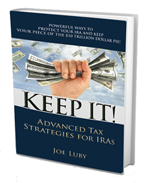Using Qualified Disclaimers as a Hedge for Tax Uncertainty
Categories: Wealth Transfer StrategiesUsing Qualified Disclaimers as a Hedge for Tax Uncertainty – Wealth Strategies Journal 2.0 (Beta)
As Seen In Wealth Strategies Journal, October 2010
Article By: Joe Luby, CFP®
Use this simple and unique solution to add flexibility in dealing with estate tax uncertainty
What a remarkable time to be in the business of advising wealthy families on financial, tax and estate issues! It’s remarkable both in terms of the changes and significant developments in the field, as well as for the opportunity afforded us as advisors to set ourselves apart and proactively solve client concerns. Many practitioners are hamstrung this year with indecision, worry and fear about what may or may not happen with income taxes, estate tax, generation-skipping transfer (GST) tax, etc. It’s unfortunate for their clients because we’re situated in the perfect tsunami of wealth transfer opportunities. Asset values are way down, tax rates are the lowest they’re going to be in most of our lifetimes and interest rates are near zero. Wealth transfer strategies should be on the top of advisors’ minds right now.
As of this writing, it doesn’t look like Congress will act anytime soon on estate tax reform legislation. Common expectations in the industry expect Congress to eventually enact some version of the law we had in 2009, perhaps with some minor variations. No one knows for sure, but that seems to be the consensus lately. One fear commonly expressed by practitioners nationwide is that Congress could try to enact retroactive legislation and thereby disrupt any transactions put in place today. For example, if they retroactively raised the gift tax to 45 percent or 55 percent from the current 35 percent, then gifts made today become more expensive. The same fear applies to a retroactive GST tax, which could create a double whammy for gifts made in 2010.
Simple Solution
There’s a simple but unique solution to these concerns: the qualified disclaimer (QD). In short, to be a QD under Internal Revenue Code Section 2518(b), the QD must:
· be in writing; and
· be made within nine months of the date of gift or the date the recipient reaches age 21, whichever is later.
Additionally, the recipient may not have accepted the gift, used the gifted asset(s) or benefited from them. The recipient may not direct where the gifted asset(s) goes upon receipt of the QD (that is, the gift either reverts back to the giver or to the next designated beneficiary, if applicable).
Most of us think of QDs for post-mortem planning opportunities. For example, the primary beneficiary of a retirement account may use a QD to redirect the funds to the contingent beneficiary for a variety of reasons. Or, a surviving spouse may use a QD for all or some of the assets in a disclaimer trust,” which specifically incorporates the QD as part of the upfront planning.
In 2010, clients can use QD planning for lifetime gifts to add flexibility and a solution to the issues described above. Taxable gifts made between now and Dec. 31 are subject to the current gift tax rate of 35 percent under 2010 law. If we wait to see whether Congress acts retroactively with an increased gift tax rate or GST tax, we will wait ourselves and clients right into 2011 when we know the rate is scheduled to go up. The time to act is NOW. Clients can use the QD procedure to undo the gift later, should Congress enact a retroactive tax increase.
Example
Take the following example: Tom Clark would like to gift $2 million of marketable securities to his son Bill. He establishes a trust naming Bill as primary beneficiary and his wife, Mary Clark as contingent. The trust is drafted to qualify as a completed gift for tax purposes, and Tom funds the trust with the $2 million securities portfolio. The family now has nine months (assuming Bill is age 21 or older) to decide if they want the gift to stand. Should Congress enact a retroactive increase in the gift tax, Bill will simply disclaim his interest in the trust, which then flows to Mary as contingent beneficiary. The entire transaction is gift tax-free if this option is triggered since the gift is now between spouses. And if the gift tax rate isn’t increased retroactively, the Clarks have locked in the lower gift tax rate by completing the transaction in 2010.
The same set of circumstances applies to gifts made to grandchildren in the event a retroactive GST is enacted. Grandparents can use this opportunity to shift significant wealth using the reduced gift tax rate in effect for 2010 and no GST tax, while still retaining flexibility in their planning if necessary to undo the gift.
Additional opportunities are present when using QD planning this year as well. Assume Congress doesn’t act retroactively and thus the current 2010 gift tax rate of 35 percent applies. However, Tom’s $2 million portfolio suffers significant losses and drops significantly. The QD option allows the family to reconsider whether paying the gift tax on $2 million (even at the lower rate in 2010) is really the best strategy. It may make sense to undo the gift via QD and structure a new gift of the now devalued assets, even though the nominal tax rate may be higher in 2011. If the assets are depressed in value already due to market turmoil over the last few years, the reverse may apply. If the $2 million portfolio recovers significantly in value, the family wins by having locked in the gift now in 2010 at the lower value and reduced gift tax rate.
Discounted Value Assets
Lastly, any gifting strategy using QDs can be greatly enhanced with the use of discounted value assets. The net after-tax impact of the gifting strategies described above is even higher when the asset gifted is subject to valuation adjustments. Examples of such assets are fractional real estate interests, closely held business interests and private investment funds. For example, an asset subject to a 30 percent discount results in a net effective federal gift tax rate on the full asset value of less than 25 percent. So not only can the client lock in 2010’s lower gift tax rate with the flexibility to undo the transaction later, but also he can even reduce the effective rate via proper advanced planning.

